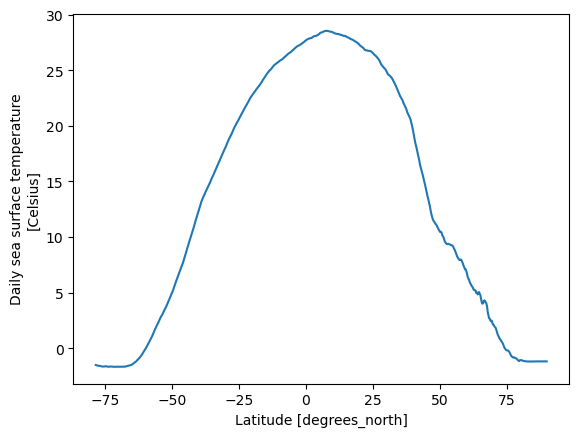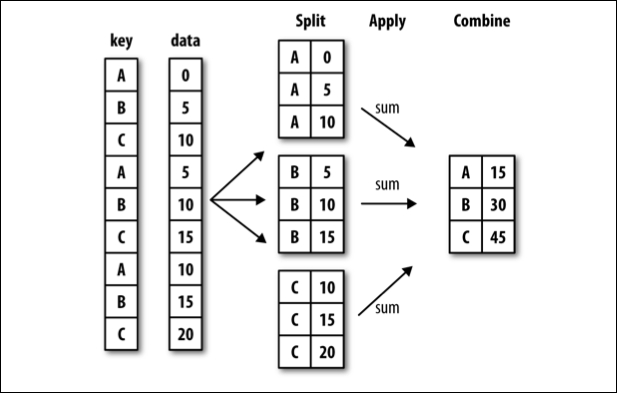xarray Groupby#
Lesson Content
groupby
groupby bins
Context#
Yesterday we began to explore working with data in xarray. Today we are going to dig into that even deeper with a concept called groupby. Groupby is going to allow us to split our data up into different categories and analyze them based on those categories. It sounds a bit abstract right now, but just wait - it’s powerful!
import xarray as xr
sst = xr.open_dataset("https://www.ncei.noaa.gov/thredds/dodsC/OisstBase/NetCDF/V2.1/AVHRR/198210/oisst-avhrr-v02r01.19821007.nc")
sst = sst['sst'].squeeze(dim='zlev', drop=True)
---------------------------------------------------------------------------
KeyError Traceback (most recent call last)
File ~/miniconda3/envs/sarp/lib/python3.10/site-packages/xarray/backends/file_manager.py:211, in CachingFileManager._acquire_with_cache_info(self, needs_lock)
210 try:
--> 211 file = self._cache[self._key]
212 except KeyError:
File ~/miniconda3/envs/sarp/lib/python3.10/site-packages/xarray/backends/lru_cache.py:56, in LRUCache.__getitem__(self, key)
55 with self._lock:
---> 56 value = self._cache[key]
57 self._cache.move_to_end(key)
KeyError: [<class 'netCDF4._netCDF4.Dataset'>, ('https://www.ncei.noaa.gov/thredds/dodsC/OisstBase/NetCDF/V2.1/AVHRR/198210/oisst-avhrr-v02r01.19821007.nc',), 'r', (('clobber', True), ('diskless', False), ('format', 'NETCDF4'), ('persist', False)), 'de82db90-3943-48cd-b456-a705eaa5cc26']
During handling of the above exception, another exception occurred:
KeyboardInterrupt Traceback (most recent call last)
Cell In[2], line 1
----> 1 sst = xr.open_dataset("https://www.ncei.noaa.gov/thredds/dodsC/OisstBase/NetCDF/V2.1/AVHRR/198210/oisst-avhrr-v02r01.19821007.nc")
3 sst = sst['sst'].squeeze(dim='zlev', drop=True)
File ~/miniconda3/envs/sarp/lib/python3.10/site-packages/xarray/backends/api.py:570, in open_dataset(filename_or_obj, engine, chunks, cache, decode_cf, mask_and_scale, decode_times, decode_timedelta, use_cftime, concat_characters, decode_coords, drop_variables, inline_array, chunked_array_type, from_array_kwargs, backend_kwargs, **kwargs)
558 decoders = _resolve_decoders_kwargs(
559 decode_cf,
560 open_backend_dataset_parameters=backend.open_dataset_parameters,
(...)
566 decode_coords=decode_coords,
567 )
569 overwrite_encoded_chunks = kwargs.pop("overwrite_encoded_chunks", None)
--> 570 backend_ds = backend.open_dataset(
571 filename_or_obj,
572 drop_variables=drop_variables,
573 **decoders,
574 **kwargs,
575 )
576 ds = _dataset_from_backend_dataset(
577 backend_ds,
578 filename_or_obj,
(...)
588 **kwargs,
589 )
590 return ds
File ~/miniconda3/envs/sarp/lib/python3.10/site-packages/xarray/backends/netCDF4_.py:602, in NetCDF4BackendEntrypoint.open_dataset(self, filename_or_obj, mask_and_scale, decode_times, concat_characters, decode_coords, drop_variables, use_cftime, decode_timedelta, group, mode, format, clobber, diskless, persist, lock, autoclose)
581 def open_dataset( # type: ignore[override] # allow LSP violation, not supporting **kwargs
582 self,
583 filename_or_obj: str | os.PathLike[Any] | BufferedIOBase | AbstractDataStore,
(...)
599 autoclose=False,
600 ) -> Dataset:
601 filename_or_obj = _normalize_path(filename_or_obj)
--> 602 store = NetCDF4DataStore.open(
603 filename_or_obj,
604 mode=mode,
605 format=format,
606 group=group,
607 clobber=clobber,
608 diskless=diskless,
609 persist=persist,
610 lock=lock,
611 autoclose=autoclose,
612 )
614 store_entrypoint = StoreBackendEntrypoint()
615 with close_on_error(store):
File ~/miniconda3/envs/sarp/lib/python3.10/site-packages/xarray/backends/netCDF4_.py:400, in NetCDF4DataStore.open(cls, filename, mode, format, group, clobber, diskless, persist, lock, lock_maker, autoclose)
394 kwargs = dict(
395 clobber=clobber, diskless=diskless, persist=persist, format=format
396 )
397 manager = CachingFileManager(
398 netCDF4.Dataset, filename, mode=mode, kwargs=kwargs
399 )
--> 400 return cls(manager, group=group, mode=mode, lock=lock, autoclose=autoclose)
File ~/miniconda3/envs/sarp/lib/python3.10/site-packages/xarray/backends/netCDF4_.py:347, in NetCDF4DataStore.__init__(self, manager, group, mode, lock, autoclose)
345 self._group = group
346 self._mode = mode
--> 347 self.format = self.ds.data_model
348 self._filename = self.ds.filepath()
349 self.is_remote = is_remote_uri(self._filename)
File ~/miniconda3/envs/sarp/lib/python3.10/site-packages/xarray/backends/netCDF4_.py:409, in NetCDF4DataStore.ds(self)
407 @property
408 def ds(self):
--> 409 return self._acquire()
File ~/miniconda3/envs/sarp/lib/python3.10/site-packages/xarray/backends/netCDF4_.py:403, in NetCDF4DataStore._acquire(self, needs_lock)
402 def _acquire(self, needs_lock=True):
--> 403 with self._manager.acquire_context(needs_lock) as root:
404 ds = _nc4_require_group(root, self._group, self._mode)
405 return ds
File ~/miniconda3/envs/sarp/lib/python3.10/contextlib.py:135, in _GeneratorContextManager.__enter__(self)
133 del self.args, self.kwds, self.func
134 try:
--> 135 return next(self.gen)
136 except StopIteration:
137 raise RuntimeError("generator didn't yield") from None
File ~/miniconda3/envs/sarp/lib/python3.10/site-packages/xarray/backends/file_manager.py:199, in CachingFileManager.acquire_context(self, needs_lock)
196 @contextlib.contextmanager
197 def acquire_context(self, needs_lock=True):
198 """Context manager for acquiring a file."""
--> 199 file, cached = self._acquire_with_cache_info(needs_lock)
200 try:
201 yield file
File ~/miniconda3/envs/sarp/lib/python3.10/site-packages/xarray/backends/file_manager.py:217, in CachingFileManager._acquire_with_cache_info(self, needs_lock)
215 kwargs = kwargs.copy()
216 kwargs["mode"] = self._mode
--> 217 file = self._opener(*self._args, **kwargs)
218 if self._mode == "w":
219 # ensure file doesn't get overridden when opened again
220 self._mode = "a"
File src/netCDF4/_netCDF4.pyx:2487, in netCDF4._netCDF4.Dataset.__init__()
File src/netCDF4/_netCDF4.pyx:2010, in genexpr()
File src/netCDF4/_netCDF4.pyx:2010, in genexpr()
File ~/miniconda3/envs/sarp/lib/python3.10/site-packages/netCDF4/utils.py:32, in _find_dim(grp, dimname)
28 def _sortbylist(A,B):
29 # sort one list (A) using the values from another list (B)
30 return [A[i] for i in sorted(range(len(A)), key=B.__getitem__)]
---> 32 def _find_dim(grp, dimname):
33 # find Dimension instance given group and name.
34 # look in current group, and parents.
35 group = grp
36 dim = None
KeyboardInterrupt:
Groupby#
While we have lots of individual gridpoints in our dataset, sometimes we don’t care about each individual reading. Instead we probably care about the aggregate of a specific group of readings.
For example:
Given the average temperature of every county in the US, what is the average temperature in each state?
Given a list of the opening dates of every Chuck E Cheese stores, how many Chuck E Cheeses were opened each year? 🧀
In xarray we answer questions like that that with groupby.
Breaking groupby into conceptual parts#
In addition to the dataframe, there are three main parts to a groupby:
Which variable we want to group together
How we want to group
The variable we want to see in the end
Without getting into syntax yet we can start by identifiying these in our two example questions.
Given the average temperature of every county in the US, what is the average temperature in each state?
Which variable to group together? -> We want to group counties into states
How do we want to group? -> Take the average
What variable do we want to look at? Temperature
Given a list of the opening dates of every Chuck E Cheese stores, how many Chuck E Cheeses were opened each year?
Which variable to group together? -> We want to group individual days into years
How do we want to group? -> Count them
What variable do we want to look at? Number of stores
📝 Check your understanding
Identify each of three main groupby parts in the following scenario:
Given the hourly temperatures for a location over the course of a month, what were the daily highs?
Which variable to group together?
How do we want to group?
What variable do we want to look at?
groupby syntax#
We can take these groupby concepts and translate them into syntax. The first two parts (which variable to group & how do we want to group) are required for pandas. The third one is optional.
Starting with just the two required variables, the general syntax is:
DATAFRAME.groupby(WHICH_GROUP).AGGREGATION()
Words in all capitals are variables. We’ll go into each part a little more below.
# We only have 1 month, so this doesn't fly here maybe on homework?
sst.groupby('time.month').mean()
<xarray.DataArray 'sst' (month: 1, lat: 720, lon: 1440)>
array([[[ nan, nan, nan, ..., nan,
nan, nan],
[ nan, nan, nan, ..., nan,
nan, nan],
[ nan, nan, nan, ..., nan,
nan, nan],
...,
[-1.1899999, -1.1899999, -1.1899999, ..., -1.1899999,
-1.1899999, -1.1899999],
[-1.1899999, -1.1899999, -1.1899999, ..., -1.1899999,
-1.1899999, -1.1899999],
[-1.1899999, -1.1899999, -1.1899999, ..., -1.1899999,
-1.1899999, -1.1899999]]], dtype=float32)
Coordinates:
* lat (lat) float32 -89.88 -89.62 -89.38 -89.12 ... 89.38 89.62 89.88
* lon (lon) float32 0.125 0.375 0.625 0.875 ... 359.1 359.4 359.6 359.9
* month (month) int64 10
Attributes:
long_name: Daily sea surface temperature
units: Celsius
valid_min: -300
valid_max: 4500
_ChunkSizes: [ 1 1 720 1440]'WHICH_GROUP'#
This can be any of the dimensions of your dataset. In physical oceanography, for example, it is common to group by latitude, so that you can see how a variable changes as you move closer to or further away from the equator.
sst.groupby('lat').mean(...)
<xarray.DataArray 'sst' (lat: 720)>
array([ nan, nan, nan, nan,
nan, nan, nan, nan,
nan, nan, nan, nan,
nan, nan, nan, nan,
nan, nan, nan, nan,
nan, nan, nan, nan,
nan, nan, nan, nan,
nan, nan, nan, nan,
nan, nan, nan, nan,
nan, nan, nan, nan,
nan, nan, nan, nan,
nan, nan, -1.51692557e+00, -1.53166163e+00,
-1.55314803e+00, -1.57018566e+00, -1.58648872e+00, -1.59056687e+00,
-1.59533656e+00, -1.61027515e+00, -1.63276756e+00, -1.64728677e+00,
-1.65520298e+00, -1.65427852e+00, -1.65435839e+00, -1.63652635e+00,
-1.64526653e+00, -1.62598121e+00, -1.63246810e+00, -1.65207720e+00,
-1.67231214e+00, -1.67294443e+00, -1.67326570e+00, -1.65209961e+00,
-1.64746606e+00, -1.65392542e+00, -1.66650736e+00, -1.67372024e+00,
-1.67431283e+00, -1.67534673e+00, -1.67392111e+00, -1.66620767e+00,
-1.66788197e+00, -1.66215181e+00, -1.65882778e+00, -1.65802693e+00,
...
1.60739255e+00, 1.40621650e+00, 1.21297944e+00, 1.08243787e+00,
9.51626062e-01, 8.30649316e-01, 7.59354472e-01, 6.84241772e-01,
5.59581220e-01, 4.71847802e-01, 3.53565246e-01, 1.82334244e-01,
4.14617397e-02, -5.61492033e-02, -1.36128694e-01, -1.94080517e-01,
-1.99803740e-01, -2.02549189e-01, -2.60961711e-01, -3.16458732e-01,
-4.41025198e-01, -5.69864392e-01, -6.84798539e-01, -7.52268314e-01,
-8.07088673e-01, -8.45351577e-01, -8.26967835e-01, -8.53520274e-01,
-8.92809749e-01, -9.03403878e-01, -9.43648040e-01, -1.00938058e+00,
-1.06675804e+00, -1.13523424e+00, -1.16256785e+00, -1.09204960e+00,
-1.07783961e+00, -1.06503558e+00, -1.09915543e+00, -1.12950087e+00,
-1.14294791e+00, -1.16515648e+00, -1.17709875e+00, -1.18073046e+00,
-1.18820989e+00, -1.18804479e+00, -1.18709552e+00, -1.19452322e+00,
-1.20153499e+00, -1.20323992e+00, -1.20159018e+00, -1.19786108e+00,
-1.19466662e+00, -1.19252777e+00, -1.19127083e+00, -1.19085419e+00,
-1.19068742e+00, -1.19081247e+00, -1.19086802e+00, -1.19065273e+00,
-1.19079864e+00, -1.19093752e+00, -1.19086802e+00, -1.19090271e+00,
-1.19074297e+00, -1.19078457e+00, -1.19062495e+00, -1.19081247e+00,
-1.19086790e+00, -1.19059026e+00, -1.19079864e+00, -1.19078457e+00,
-1.19057631e+00, -1.19061089e+00, -1.18999982e+00, -1.18999982e+00],
dtype=float32)
Coordinates:
* lat (lat) float32 -89.88 -89.62 -89.38 -89.12 ... 89.38 89.62 89.88
Attributes:
long_name: Daily sea surface temperature
units: Celsius
valid_min: -300
valid_max: 4500
_ChunkSizes: [ 1 1 720 1440]AGGREGATION#
The goal with each of the groups of data is to end up with a single value for the things in that group. To tell xarray how to gather the datapoints together we specify which function we would like it to use. Any of the aggregation functions we talked about at the beginning of the lesson work for this!
sst.groupby('lat').mean(...).plot()
[<matplotlib.lines.Line2D at 0x163c46290>]

What do we see? Hot water near the equator and chilly water near the poles.
Note
The ellipses ... inside the .mean() tell xarray to take the mean over all of the remaining axis. You wouldn’t have to do that - you may instead want to take the mean over just the latitude and keep the time resolution. It’s quite common, though, to want to aggregate over all remaining axis.
time dimension#
If your data has a time dimension and it is formatted as a datetime object you can take advantage of some slick grouping capabilities. For example, you can group by a time group like 'time.month', which will grab all make 12 groups for you, putting all the data from each month into its own group.
# We only have 1 month, so this doesn't fly here maybe on homework?
sst.groupby('time.month').mean()
<xarray.DataArray 'sst' (month: 1, lat: 720, lon: 1440)>
array([[[ nan, nan, nan, ..., nan,
nan, nan],
[ nan, nan, nan, ..., nan,
nan, nan],
[ nan, nan, nan, ..., nan,
nan, nan],
...,
[-1.1899999, -1.1899999, -1.1899999, ..., -1.1899999,
-1.1899999, -1.1899999],
[-1.1899999, -1.1899999, -1.1899999, ..., -1.1899999,
-1.1899999, -1.1899999],
[-1.1899999, -1.1899999, -1.1899999, ..., -1.1899999,
-1.1899999, -1.1899999]]], dtype=float32)
Coordinates:
* lat (lat) float32 -89.88 -89.62 -89.38 -89.12 ... 89.38 89.62 89.88
* lon (lon) float32 0.125 0.375 0.625 0.875 ... 359.1 359.4 359.6 359.9
* month (month) int64 10
Attributes:
long_name: Daily sea surface temperature
units: Celsius
valid_min: -300
valid_max: 4500
_ChunkSizes: [ 1 1 720 1440]Note: bluk of this lesson I think is complete.
It may be nice to have a different dataset for this one. Something with higher dimensionality and perhaps even a group with species names or something in it.
groupby bins#
Breaking down the process#
There is a lot that happens in a single step with groupby and it can be a lot to take in. One way to mentally situate this process is to think about split-apply-combine.
split-apply-combine breaks down the groupby process into those three steps:
SPLIT the full data set into groups. Split is related to the question Which variable to group together?
APPLY the aggregation function to the individual groups. Apply is related to the question How do we want to group?
COMBINE the aggregated data into a new dataframe

